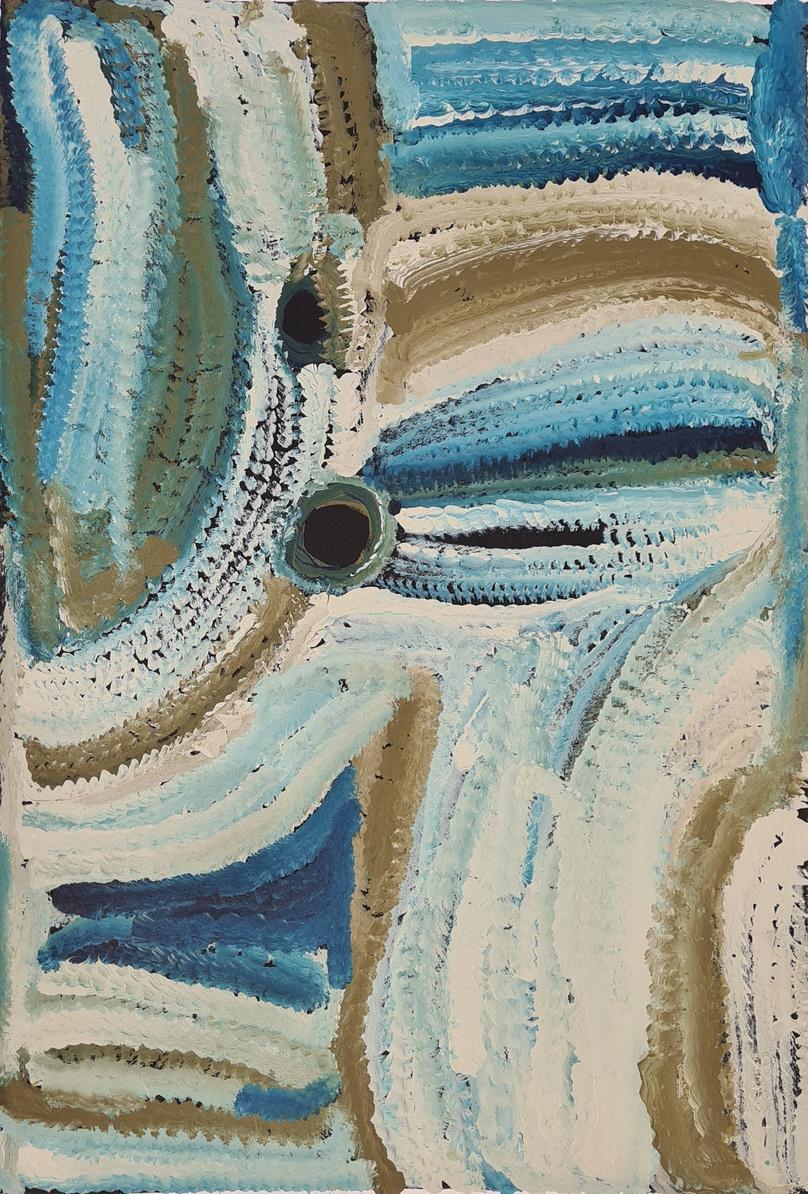
2 minute read
NANCY NYANJILPAYI (NGARNJAPAYI) CHAPMAN
from CROSSING COUNTRY
Nyanjilpayi is a Manyjilyjarra woman, born in the 1940s at Jarntinti, a large claypan at the southern end of Nyayartakujarra (Lake Dora) and within the Karlamilyi (Rudall River) region She is the sister of fellow senior Martumili Artists Mulyatingki Marney, Mayiwalku Chapman and Marjorie Yates (dec) As children, Nyanjilpayi and her family walked around the Punmu, Kunawarritji (Canning Stock Route Well 33) and Karlamilyi regions A severe and prolonged drought extended through many years during this formative period in her life, and Nyanjilpayi remembers this as a difficult time Although her family knew about the mission at Jigalong, where a supply of rationed food and water was assured, they chose to continue to live nomadically and independently for many years

Jutupa is a waterhole located yulparirra (south) of Punmu Aboriginal Community, and at the southern edge of Nyayartakujarra (Ngayarta Kujarra Lake Dora) The site falls within the Karlamilyi (Rudall River) region, an area created by the Jila Kujarra (Two Snakes) as they journeyed north east to Nyayartakujarra Surrounding Jutupa are the distinctive long tali (sandhills) of Martu Country Other nearby water sources include Pinjupinya, Wawul , Tarl , and Jarntinti
This site lies within Nyanjilpayi’s ngurra (home Country, camp), the area which she travelled extensively around with her family as a young girl Nyanjilpayi recollects staying here as a child with her two Sisters Mayiwalku May Chapman and Mulyatingki Marney, her brother , father and three mothers Here they would collect kalaru (Samphire, salt bush) seed In the pujiman (traditional desert dwelling) era the black kalaru seeds were used to produce damper, a type of flat bread. The seeds were first washed several times before being ground with a jiwa (stones used by women for grinding seeds) to make a flour which was then mixed with water to create a dough that was finally cooked in the ashes of a fire
I'm working on my painting of those waterholes , I was drinking from them long ago as a pujiman. My family's water , my grandmother's, my grandfathers and my ancestors. I was taught from them. Our knowledge is ancient and has been passed on by our grandparents. Young people need to keep looking after it.


Yirrajarra comprises of two soaks situated near Lake Auld , and north of Tiwa (Canning Stock Route Well 26) As the site of a continuous source of good fresh water , surrounded by plentiful puri (shade) Yirrajarra was an important semi-permanent camping ground during the pujiman era. This site lies within Nyanjilpayi’s ngurra through her grandfather, and forms part of the area which she knew intimately and travelled extensively with her mother , father and two sisters in her youth.
During the pujiman period, Martu would traverse very large distances annually in small family groups, moving seasonally from water source to water source , and hunting and gathering bush tucker as they went At this time knowledge of water sources was critical for survival , and today Martu Country is still defined in terms of the location and type of water Each of the hundreds of claypans, rockholes waterholes soaks and springs found in the Martu desert homelands is known by name , location , quality and seasonal availability through real life experience and the recounting of Jukurrpa (Dreaming) narratives

Yirrajarra, good name. [In the] winter time , cold time , you gotta have a look. One side two claypan, another side soak water. Jamu mili [my grandfather's] Country. I been walking there with my mummy, daddy, [and my sisters] Mayiwalku [May Chapman], Mulyatingki [Marney]. All walking around pujiman time.










